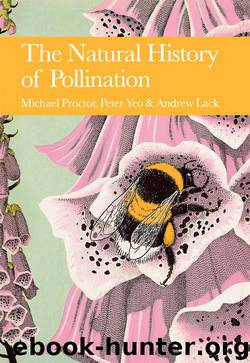The Natural History of Pollination by Michael Proctor

Author:Michael Proctor [Michael Proctor, Peter Yeo and Andrew Lack]
Language: eng
Format: epub
ISBN: 9780007383115
Publisher: HarperCollins Publishers
Other wind-pollinated herbs
The flowers of grasses and sedges are so specialised for wind pollination that they bear little resemblance to insect-pollinated flowers. Among the remaining wind-pollinated herbs, an entomophilous ancestry is often obvious. Thus the rushes (Juncaceae) have a small chaffy perianth, large stamens and large rough stigmas (Fig. 9.18), but the arrangement of the parts of the flower leaves no doubt that they are closely related to the lily family (Liliaceae). The plantains (Plantago, family Plantaginaceae) (Fig. 9.19) have no close typically entomophilous relatives, but are comparable with the rushes in their adaptations to wind pollination – though in no way related to them. The corolla is small and membranous, and the strongly protogynous flowers have long, rough stigmas and large versatile anthers borne on long filaments (Fig. 9.20). Some species, such as the hoary plantain (P. media), which has conspicuous heads and is slightly scented, are visited by insects; they are probably another case (like the willows and some further examples considered below) in which there is a balance between insect and wind pollination (Stelleman, 1981).
Download
This site does not store any files on its server. We only index and link to content provided by other sites. Please contact the content providers to delete copyright contents if any and email us, we'll remove relevant links or contents immediately.
| Cacti & Succulents | Flowers |
| Mushrooms | Trees |
Sapiens: A Brief History of Humankind by Yuval Noah Harari(14257)
The Tidewater Tales by John Barth(12609)
Mastermind: How to Think Like Sherlock Holmes by Maria Konnikova(7233)
Do No Harm Stories of Life, Death and Brain Surgery by Henry Marsh(6891)
The Thirst by Nesbo Jo(6832)
Why We Sleep: Unlocking the Power of Sleep and Dreams by Matthew Walker(6620)
Life 3.0: Being Human in the Age of Artificial Intelligence by Tegmark Max(5478)
Sapiens by Yuval Noah Harari(5295)
The Longevity Diet by Valter Longo(5021)
The Body: A Guide for Occupants by Bill Bryson(4978)
The Rules Do Not Apply by Ariel Levy(4866)
The Immortal Life of Henrietta Lacks by Rebecca Skloot(4528)
Animal Frequency by Melissa Alvarez(4399)
Why We Sleep by Matthew Walker(4362)
The Hacking of the American Mind by Robert H. Lustig(4319)
Yoga Anatomy by Kaminoff Leslie(4309)
All Creatures Great and Small by James Herriot(4233)
Double Down (Diary of a Wimpy Kid Book 11) by Jeff Kinney(4209)
Embedded Programming with Modern C++ Cookbook by Igor Viarheichyk(4108)
